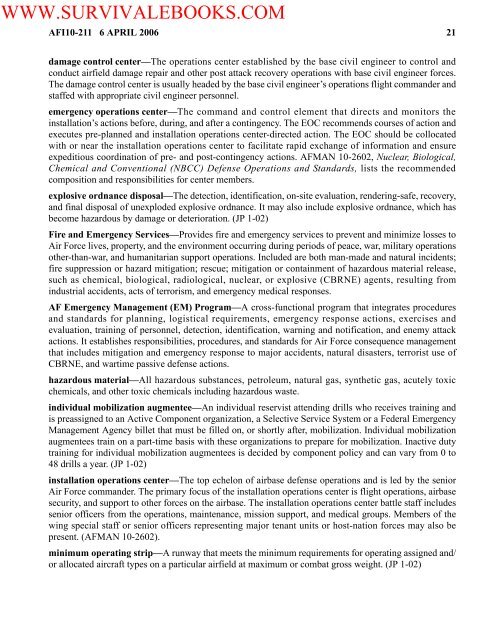2006 US Air Force CIVIL ENGINEER ... - Survival Books
2006 US Air Force CIVIL ENGINEER ... - Survival Books
2006 US Air Force CIVIL ENGINEER ... - Survival Books
- No tags were found...
You also want an ePaper? Increase the reach of your titles
YUMPU automatically turns print PDFs into web optimized ePapers that Google loves.
WWW.SURVIVALEBOOKS.COMAFI10-211 6 APRIL <strong>2006</strong> 21damage control center—The operations center established by the base civil engineer to control andconduct airfield damage repair and other post attack recovery operations with base civil engineer forces.The damage control center is usually headed by the base civil engineer’s operations flight commander andstaffed with appropriate civil engineer personnel.emergency operations center—The command and control element that directs and monitors theinstallation’s actions before, during, and after a contingency. The EOC recommends courses of action andexecutes pre-planned and installation operations center-directed action. The EOC should be collocatedwith or near the installation operations center to facilitate rapid exchange of information and ensureexpeditious coordination of pre- and post-contingency actions. AFMAN 10-2602, Nuclear, Biological,Chemical and Conventional (NBCC) Defense Operations and Standards, lists the recommendedcomposition and responsibilities for center members.explosive ordnance disposal—The detection, identification, on-site evaluation, rendering-safe, recovery,and final disposal of unexploded explosive ordnance. It may also include explosive ordnance, which hasbecome hazardous by damage or deterioration. (JP 1-02)Fire and Emergency Services—Provides fire and emergency services to prevent and minimize losses to<strong>Air</strong> <strong>Force</strong> lives, property, and the environment occurring during periods of peace, war, military operationsother-than-war, and humanitarian support operations. Included are both man-made and natural incidents;fire suppression or hazard mitigation; rescue; mitigation or containment of hazardous material release,such as chemical, biological, radiological, nuclear, or explosive (CBRNE) agents, resulting fromindustrial accidents, acts of terrorism, and emergency medical responses.AF Emergency Management (EM) Program—A cross-functional program that integrates proceduresand standards for planning, logistical requirements, emergency response actions, exercises andevaluation, training of personnel, detection, identification, warning and notification, and enemy attackactions. It establishes responsibilities, procedures, and standards for <strong>Air</strong> <strong>Force</strong> consequence managementthat includes mitigation and emergency response to major accidents, natural disasters, terrorist use ofCBRNE, and wartime passive defense actions.hazardous material—All hazardous substances, petroleum, natural gas, synthetic gas, acutely toxicchemicals, and other toxic chemicals including hazardous waste.individual mobilization augmentee—An individual reservist attending drills who receives training andis preassigned to an Active Component organization, a Selective Service System or a Federal EmergencyManagement Agency billet that must be filled on, or shortly after, mobilization. Individual mobilizationaugmentees train on a part-time basis with these organizations to prepare for mobilization. Inactive dutytraining for individual mobilization augmentees is decided by component policy and can vary from 0 to48 drills a year. (JP 1-02)installation operations center—The top echelon of airbase defense operations and is led by the senior<strong>Air</strong> <strong>Force</strong> commander. The primary focus of the installation operations center is flight operations, airbasesecurity, and support to other forces on the airbase. The installation operations center battle staff includessenior officers from the operations, maintenance, mission support, and medical groups. Members of thewing special staff or senior officers representing major tenant units or host-nation forces may also bepresent. (AFMAN 10-2602).minimum operating strip—A runway that meets the minimum requirements for operating assigned and/or allocated aircraft types on a particular airfield at maximum or combat gross weight. (JP 1-02)
















